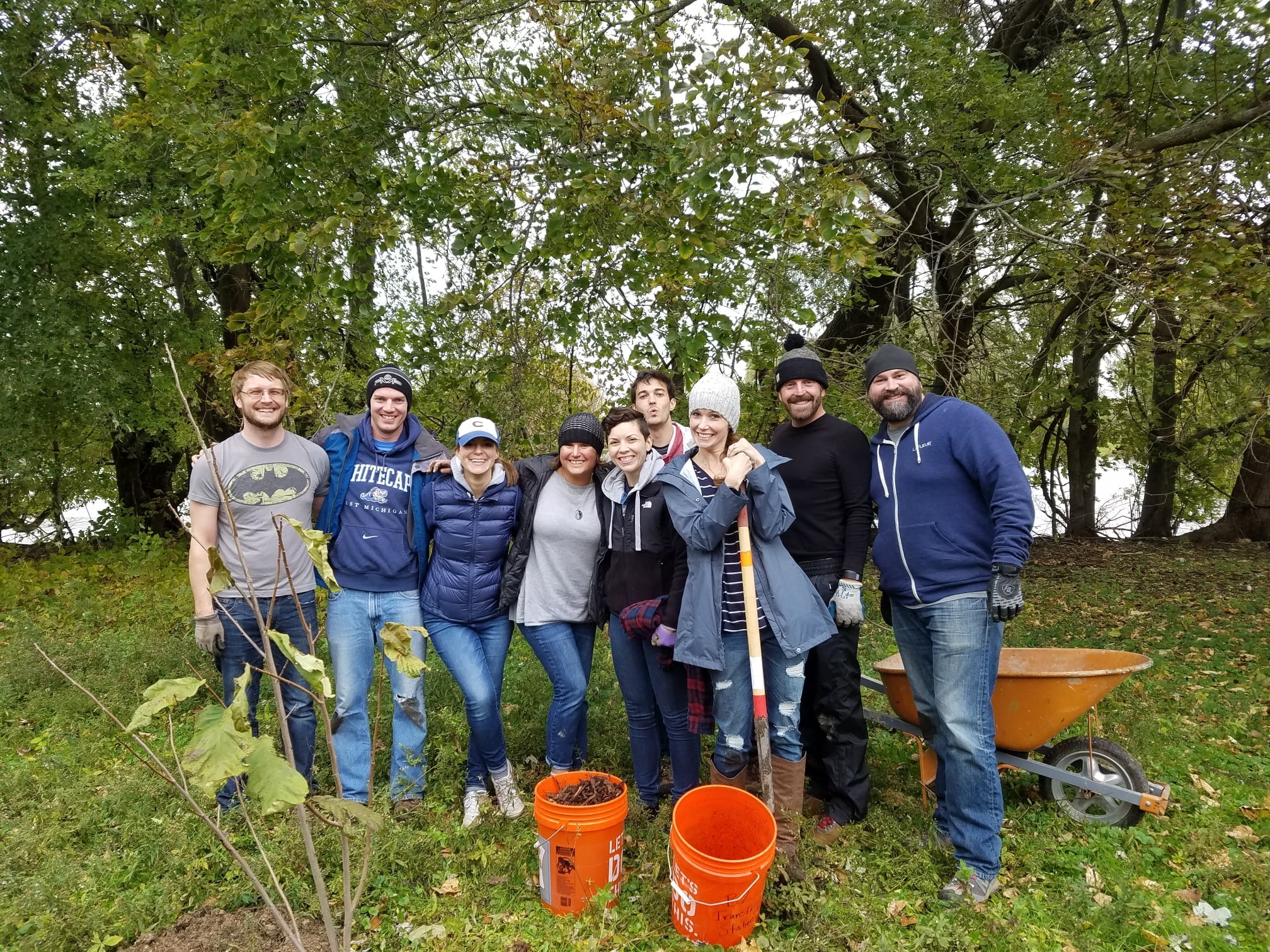As part of our community volunteer initiative, LaFleur recently partnered with Friends of Grand Rapids Parks, the Brewer’s Grove, and other volunteers focused on giving back to the community.
The group came together to replace removed ash trees lost due to the Emerald Ash Borer epidemic and plant a new grove of pawpaws. Planting these trees will help improve tree diversity within the city while also providing a source of food for wildlife and even park visitors.
After a short afternoon of planting trees in the rain, we celebrated our accomplishments with a full draft list of local beers and ciders at the bandshell. Everyone was able to enjoy these delicious refreshments while chatting with local brewers on their plans for a special tree-inspired beer to be brewed and distributed in 2019.
The Brewers Grove and Friends of Grand Rapids Parks
The Brewer’s Grove started in 2013 when Jackson VanDyke from Harmony Hall collaborated with other local brewers to decide how they could best celebrate Grand Rapids being named Beer City, USA for the first time. By 2018, there were 27 different Grand Rapids breweries participating in The Brewer’s Grove.
The seed of the idea was planted to create tree-themed beers that would be offered in conjunction with Experience GR’s Beer Month. The project is being administered by the Friends of Grand Rapids Parks, a nonprofit group advancing the Urban Forest Project canopy expansion effort.
Here are a few of the benefits of the Urban Forest Project that directly impact Grand Rapids residents:
- Intercepting stormwater
- Conserving energy
- Removing air pollutants
- Reducing and storing carbon dioxide
RELATED: Labor of Love: The LaFleur Team Celebrates Their Dedication to Our Company and Clients
Getting Our Hands Dirty
Our team worked mostly on planting the pawpaw grove near the lake in the middle of the park. In total, we planted 32 trees — 15 of them were pawpaw trees.
After a short orientation, we headed out to our assigned areas. After we split off into groups of four, everyone grabbed a shovel, pickaxe, tree, and clippers for the burlap tree wrap. Then the rain started, which was actually quite refreshing since we’d all worked up a sweat digging our holes and splitting roots with our axes. (Special shout out to David VandeWaa for sharing some excellent ax-wielding skills!)
After getting our trees in the ground and filling in the holes, we reused the sod to create a border around the top of the tree and added mulch. Thankfully, we didn’t run into any clay — just a few testy roots.
Once all the trees were in the ground, everyone headed back to the covered bandshell to reflect on our work and discuss future tree-inspired beers with local breweries and brewers. Of course, we sampled some of the best beverages Beer City, USA has to offer while we huddled together with the rain falling all around us.
With so many hands to help share the load (and the beer), it was a very “fruitful” day.
Pawpaw, the Michigan Banana
If you’ve never heard of a pawpaw tree, you’re not alone. Sometimes known as the Michigan Banana or “forgotten fruit,” settlers named the southwest Michigan city of Paw Paw after the bountiful tree. As Lewis and Clark made their way across the United States in the fall of 1806, William Clark said that he and his colleagues were “very fond” of the fruit they called the “custard apple.”
Aside from preserving food diversity, the pawpaw is an excellent addition to our tree canopy because of the fruit it produces. Pawpaws produce the largest edible fruits native to North America and have a natural resistance to pests and deer. As such, they’re included on the Slow Food Ark of Taste Program.
Unfortunately, they’re also now on the endangered list. They’ve declined in popularity and ubiquity due to a short growing season, shipping problems, and relatively brief shelf life. Unlike apples, which can be stored for months in the right conditions, the pawpaw ripens after just a couple weeks in the refrigerator.
With growing public interest in native fruits, however, it’s an up-and-coming culinary star — adding notes of pineapple, banana, and mango in its own unique bouquet. The pawpaw adds a definitive tropical flair to beer, baked goods, custard, and other desserts. So here’s hoping for a pawpaw-inspired ice cream sometime soon in West Michigan!
RELATED: The Team at LaFleur Digs Into Volunteering With Well House
Building a Better Grand Rapids, One Seed at a Time
Giving back to the community is a core part of our mission at LaFleur. Because of this, we tend to attract and retain employees who are passionate about connecting with our community.
We hope to challenge (and serve as an example to) businesses of all sizes and industries to prove that profitability and community involvement are not mutually exclusive. LaFleur hopes to lead the charge by pushing other companies to connect and give back. We feel that people and companies that are in a position to lead should do so by example — in business, philanthropy, and volunteerism — and we leverage our community outreach program to do just that.
If you’d like to learn more about partnering with LaFleur to develop new marketing initiatives or to improve your existing campaigns, please contact us by calling (888) 222-1512 or completing this brief contact form.
Or, if you’re a nonprofit organization located in West Michigan and you’d like LaFleur to consider you for our monthly volunteering efforts, please email Sarah LaFleur at [email protected] to tell us about your organization and discuss your needs.
References
Brewer’s Grove Tree Planting. (2013, July). Friends of Grand Rapids Parks. Retrieved from https://www.friendsofgrparks.org/brewers-grove/










